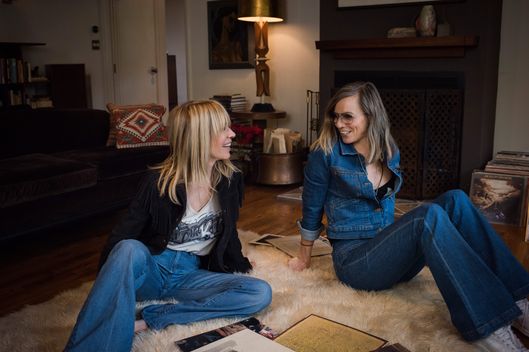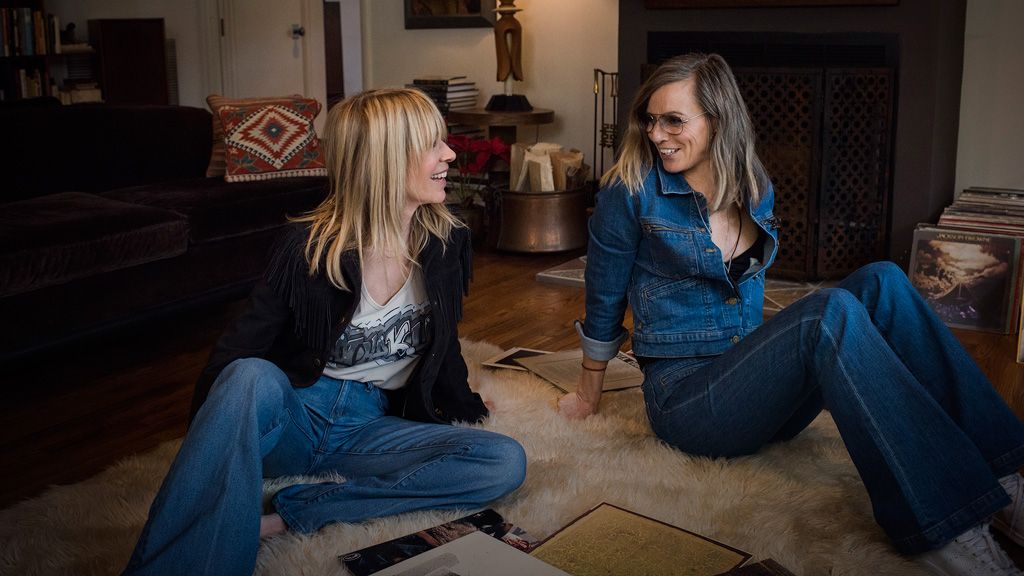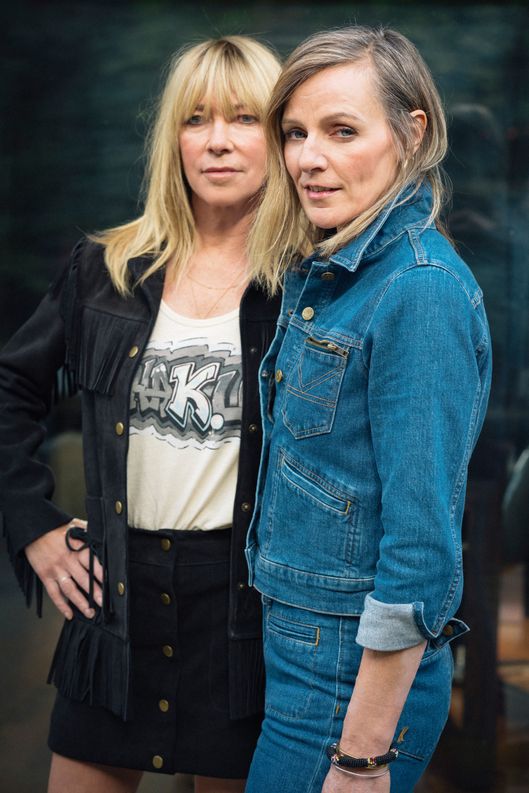Balenciaga
See it »
An afternoon in L.A., bathed in nostalgia for '90s New York.


It’s a grayish morning in Los Feliz, and Kim Gordon is late for the photo shoot where she’ll be modeling the latest Madewell collaboration. She has decided to walk from her house to the shoot, taking place inside a cozy, 1950s home decked out in vintage furniture. Everybody on set is horrified by the distance of her journey (ten minutes by foot), because, as the cliché goes, nobody walks in L.A. But these days Kim Gordon does as she pleases. In the latest chapter of her life, post–Sonic Youth, she's left the dreary East Coast winters and returned to the city she grew up in — making new art, new habits. On this particular day, she's on her way to meet her old friend Daryl Kerrigan, designer of cult '90s fashion label Daryl K. Madewell is about to release a 19-piece capsule collection with Kerrigan, for which Gordon and her 22-year-old daughter, Coco, appear in the campaign imagery. Even from down the block Gordon is unmistakable, her signature blonde bangs skimming the top of her sunglasses, her soft, pinstripe blazer tied loosely at her waist.
When Gordon arrives, the two women catch up a bit. It's been years since they've seen each other, it turns out. Right away, they talk about their kids, swiping through images on their phones the way people do these days. The home screen on Gordon's phone is the Madewell image of her and Coco. “I was surprised she wanted to be photographed. She doesn’t often want that,” Kim says of her daughter. Indeed, the seemingly born-to-be-hip Coco Gordon Moore doesn’t even have a public Instagram account. Everyone wants to talk about David Bowie, his recent death, his legacy, his style. Kerrigan can't stop watching his performances on YouTube. Gordon tells us all how much she loved playing a show with him at his 50th birthday party.
Chances are, if you ask any woman who worked downtown in the mid-'90s where she bought her favorite clothes, she's likely to mention Daryl K's shop on Bond Street. It seems impossible now, even preposterous to imagine, that 20 years ago it took a modicum of effort to find cool clothing in New York. But it’s true: "Back then, there was nothing,” as Gordon says. There were no blogs devoted to street style, no easy ways to access images of things that inspired you. "Very few stores,” she continues. “People were really into vintage, Doc Martens, Canal Jeans." Indie magazines were expensive — broke college students spent hours standing in the dirty, disorganized magazine shop on the corner of Spring and Lafayette, leafing through issues of Purple or Index or Interview and not buying them. The scavenger hunt to find a pair of leather pants (spotted on the most intimidating woman at one of the newly opened Chelsea galleries) could take weeks. You roamed certain neighborhoods simply to encounter interesting people so you could take note of their style and file it away in the Pinterest board of your mind. If you found a store or a bar that seemed special, you didn't always tell everybody about it because you had done the hard work of finding it and you might not want to "ruin" it with overexposure. You took for granted that the right people would find it on their own, like you had. Yes, this is the once-cool-40-year-old New Yorker's "I walked a mile in the snow" story, but it's true nonetheless. Besides, this might be the special appeal, to younger shoppers, of having Gordon and Kerrigan wearing a brand like Madewell: In our hyperconnected Instagram era, in which people seek constant validation of their personal taste, it’s very difficult to achieve anywhere near the level of earned cool that these two have.
“When Daryl opened her first store in the East Village in 1992, she was doing something slightly more feminine, minimal and fitted, than anybody else at the time. It felt really right," Gordon remembers. According to Gordon, she and her friend, the stylist Daisy von Furth (with whom she would go on to start X-Girl, another cult '90s clothing store for a slightly younger set), were"obsessed" with boot-cut pants. Kerrigan had that market cornered, and Gordon became one of her highest-profile fans. Gordon recalls even wearing Daryl K's signature low-slung vinyl pants as maternitywear. "Yes, they had a nice bit of stretch, didn't they?" Kerrigan teases fondly.
Kerrigan's soft, sophisticated Dublin accent adds a conspiratorial warmth to everything she says. Her blue eyes grab you from behind her tinted aviators, and her gray-blonde hair is the only thing that betrays her 51 years. Beneath her shirt, unbuttoned to the limits of acceptability, gold chains peek out in a sexy tangle. Flipping through the new collection, she whisks away a sample-size pair of high-waisted, boot-cut jeans and a denim jacket so small it could fit a child.
Gordon, meanwhile, chooses a black suede miniskirt to try on. She deems it too long, and the tailor on set shortens it to a mere 13.5 inches. Gordon's smooth, tan legs are the envy of the room, but in the end she decides to go with jeans and a T-shirt. "I've always been more of a tomboy," she explains. "I’m drawn to the type of girl who can wear just a T-shirt and plain jeans and make them her own." Kerrigan agrees: "Too much fashion ruins things." I mention that as I get older, I care less and less about male attention, that I dress more for myself than ever. “I still care,” Kim laughs. “I’m single now, after all.”

The women browse the huge record collection in the house where they're shooting, stopping occasionally to play an album. Gordon jokingly looks for covers with '70s, California vibes, "something denim-y" to match their outfits. Finding various all-male acts like the Allman Brothers and Donovan, she says quietly, almost to herself, "How about some women?" After searching for a Runaways record to no avail, she settles on Rita Coolidge's self-titled album and plays "Born Under a Bad Sign," before moving on to Fleetwood Mac's Tusk. "I met Stevie once," she tells Kerrigan. "She was so down-to-earth." It’s a sweet moment from someone who must have inspired that same comment in legions of fans herself. Even icons have their icons.
Icon isn’t a word Gordon seems comfortable with, waving that status off with a bemused shrug. I have to admit that I was never a big Sonic Youth fan when it would have been cool to be one. But I always watched Kim. She represented the woman who had figured out how to have a dynamic marriage, a creative life, a prominent place in a male-dominated field, a child — and always great style. Lately, though I’ve been more interested in her than ever. In the aftermath of her divorce and the breakup of her band, Gordon has almost single-handedly redefined what it means to be over 60. She and Kerrigan, with their wonderful, no-Botox faces and joyful girlishness, appear to be pioneering a new kind of aging, one that seems to reject the notion that women become invisible. In fact, I'm dying for examples of women who let themselves just look like they look; women like Inès de la Fressange, or Linda Rodin with her gorgeous wrinkles, or even much older women like Iris Apfel: They represent a future in which women remain bright, chic, and even gain relevance and personal confidence with age.
Gordon and her daughter also recently modeled for Marc Jacobs's fall 2015 campaign; in an ad, the duo stare down the camera with a compound ferocity. Gordon isn't so much passing the torch as inviting a new generation to share the stage. And that generosity, it seems to me, is part of what makes Gordon inspiring in a way that’s even more revolutionary than the way she was cool 25 years ago. She’s learned how to be at ease. "Everybody thinks that everything has to be about success and upward and bigger and more and more,” she says, “but it doesn't have to be like that.”
To be fair, it was a 13 foot-long dress.
You and Rihanna Will Both Want to Invest in Dior’s New BagIt's got something for everyone.
Polo Shirts Have Turned Their Back on Ryan LochteAlong with his other major sponsors.
Ryan Lochte Will No Longer Be Paid to Wear Tiny Bathing SuitsSpeedo remains committed to transparency.
Laura Brown Is the New Editor-in-Chief of InStyleAfter 11 years at Harper’s Bazaar.
Tyra Banks Is Going to Teach a Class on Smizing at Stanford"If I see somebody not paying attention, I’m gonna call on them."
This Floating Pier Is the Most Zen Installation EverWalking on water in Italy.
Nation Is Appalled by Matt Lauer’s Nude Ankles During Ryan Lochte InterviewWhat’s the opposite of “Jeah”?
8 People at the Life of Pablo Pop-up Explain Why Kanye West Is a God"I mean, Kanye West is just Kanye West. There's not more or less you can say about Kanye West. He's just Mr. West!"
A T-shirt Is EnoughSimplicity, versatility, and cool. What more could you want?
She took a perfect pencil dive off a 30-foot yacht.
American Apparel Is Being Sued by Former WorkersAs the company considers putting itself up for sale.
A Gendered History of the Tailored SuitFrom Marlon Brando to Coco Chanel.
How Zendaya Developed Such Great Style at the Young Age of 19The star's best looks from Disney to now.
Proof That If You’re Chic Enough, a Little Federal Investigation Doesn’t MatterIs this the best they could do?
5,300-Year-Old Mummified Iceman Probably Would’ve Been a Street-Style StarHe had several different looks and was “pretty picky.”
J.Crew Has Identified 226 Shades of PinkEven more than there are shades of gray.
Gigi and Bella Hadid Merch Is Now Somehow a Thing That Is HappeningToday in Hadidiana.
Gird Your Loins for the Return of Yeezy to New York Fashion WeekThe season approaches.
This Indie Brand Had a Great Response to Ivanka TrumpWhen she bought one of their cuffs, they donated the proceeds to the Clinton campaign.